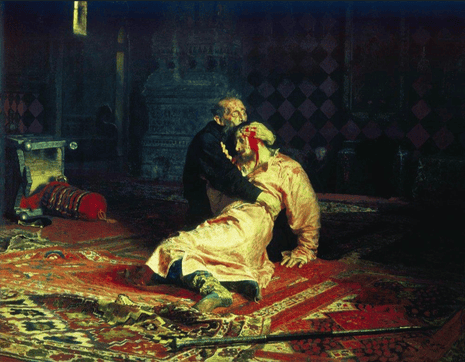One of Russia’s most famous and controversial paintings, which depicts Ivan the Terrible cradling his dying son, has been badly damaged after a man attacked it with a metal pole in a Moscow gallery.
The canvas – Ivan the Terrible and His Son Ivan on November 16, 1581 – was completed by the Russian realist Ilya Repin in 1885 and portrays a grief-stricken tsar holding his son in his arms after dealing him a mortal blow, a historical incident the veracity of which some Russian nationalists dispute.
In a video released by the interior ministry, the unnamed suspect appears to confess, saying he went to see the painting before drinking vodka and becoming “overwhelmed by something”.
Ivan the Terrible is regarded as one of the cruellest rulers in Russia’s long history: a bloodthirsty and paranoid tyrant who killed his own son. But the figure of the 16th-century tsar has recently has undergone something of a rehabilitation in modern Russia, with some nationalists arguing that the painting in question was actually part of a foreign smear campaign.
The State Tretyakov gallery in central Moscow said a man attacked the canvas just before closing time on Friday .
It said he got past a group of gallery staff, picked up one of the metal security poles used to keep the public away from the painting and struck its protective glass covering several times.
“As a result of the blows the thick glass ... was smashed,” the gallery said. “Serious damage was done to the painting. The canvas was pierced in three places in the central part of the work which depicts the figure of the tsarevich [the tsar’s son].”
The frame was also badly damaged, the gallery said, but that “by a happy coincidence” the most precious elements of the painting – the depiction of the faces and hands of the tsar and his son – were not damaged.
The attacker was detained and faces being charged with damaging a cultural artefact. Russian news agencies cited police sources saying he was a 37-year-old man from the city of Voronezh about 286 miles (460km) from Moscow. He faces up to three years in prison and a 3m ruble fine (£33,000), according to the RIA Novosti agency.
In the interior ministry’s video, the man says he recognised the seriousness of his crime. “I came to look at the painting,” the man reportedly told police. “I wanted to leave, but then dropped into the [gallery’s] buffet and drank 100g of vodka. I don’t drink vodka and became overwhelmed by something.”
Some Russian media cited him as saying he had attacked the painting because he thought the depiction was inaccurate. Russian nationalists who object to the painting and dispute the veracity of the scene have previously demanded the gallery remove it from display, which the Tretyakov has refused to do.
Battles over historical narratives in Russia have become increasingly heated under Vladimir Putin as the Kremlin pushes a more positive, patriotic view of Russian history.
Though these controversies have focused largely on Stalin’s legacy and the second world war, Ivan the Terrible has not been exempt.
In 2013, a group of Orthodox Christian activists wrote an open letter to the Russian culture ministry alleging that the painting offended Russians and presented a distorted view of Russian history. Irina Lebedeva, then director of the Tretyakov gallery, said at the time that the gallery would not take the painting down.
In 2016, the first monument to Ivan was unveiled in Oryol, about 200 miles south-west of Moscow, ostensibly to mark 450 years since he founded the town.
At the time, Oryol’s governor, Vadim Potomsky, the project’s main cheerleader, said Ivan’s bad reputation was partly down to a foreign plot.
“He was a great Russian tsar, the first real tsar,” he said. “People present him as a tyrant and psychological deviant. But if you take European leaders of his period, they were many times more bloodthirsty, but in Europe they have monuments, and nobody minds.”
Last year, Putin weighed in on history’s understanding of Ivan.
“Many researchers think that he didn’t kill anyone at all,” Putin said, “and that this was concocted by a Papal emissary who came to Russia for negotiations and wanted to turn Orthodox Russia into Catholic Russia ... But after Ivan refused and told him to get lost, several legends began to spring up. They began to label him ‘Ivan the Terrible’.”
The painting has a complicated history. Inspired by the assassination of Tsar Alexander II in 1881, Repin completed the work in 1885 and it was purchased by the Moscow merchant Pavel Tretyakov for display in his namesake gallery. But the painting offended Tsar Alexander III and it was temporarily banned from public display.
The canvas was also attacked in 1913 by a mentally ill man who slashed it with a knife three times. Repin was still alive at the time and personally restored it.
The Tretyakov gallery has said there is hope for it to be restored once again after the latest attack. The gallery said it was convening a special commission of leading Russian experts to plan a course of action and oversee its restoration, which will likely take several years, if previous restoration efforts are any indication.
Olga Temerina, the deputy head of the Grabar Art Conservation Centre in Moscow, told RIA Novosti that the canvas may need to be replaced, but that the centre still had Repin’s notes from the previous restoration effort to help.
“[The] situation now, if you believe the description, is not quite a tragedy,” she said.
